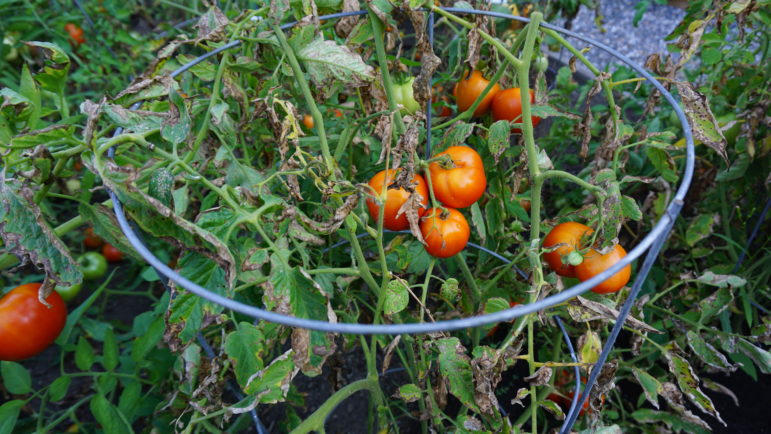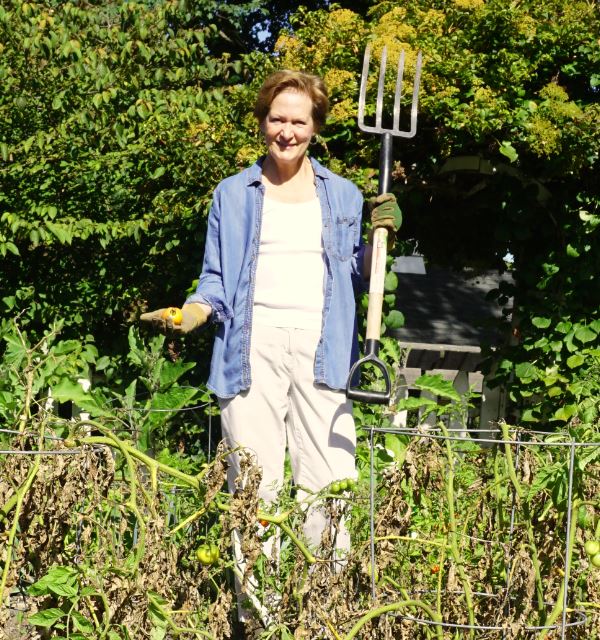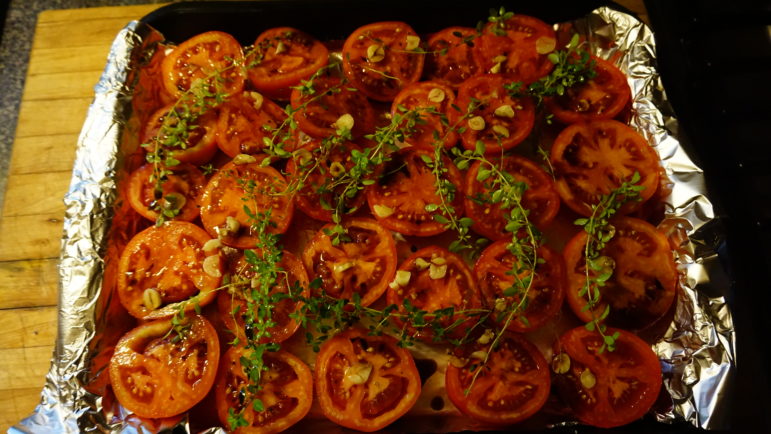
‘You’ve come a long way, bambina,’ I tell myself, reluctantly pulling up the last of the plum tomato plants for the season. It’s officially autumn after all, though the cool night breeze wafting through the bedroom window told me as much way before the calendar. Still, there’s a few brave orange stragglers holding on for dear life in the afternoon sun. Likewise, three Early Girls and a chorus of cherries.
I find a perfectly ripe, ruby red gem the size of a Jacks ball and pop it in my m outh. The explosion is at once hot and sweet, herbaceous and earthy. For one euphoric moment I forget all that’s wrong with the world and celebrate the notion that these treasures grew from our labors on a humble 20’ x 20’ plot of land we call our own.
outh. The explosion is at once hot and sweet, herbaceous and earthy. For one euphoric moment I forget all that’s wrong with the world and celebrate the notion that these treasures grew from our labors on a humble 20’ x 20’ plot of land we call our own.
Yes, it was a good tomato year. We – myself, my husband, and even our younger daughter – worked arm in arm with Mother Nature to provide ideal growing conditions. Foregoing any overhead sprinkling during desert dry days as in years past – tomatoes are infamous for their temperamental intolerance of splashing water on their well-dressed leaves – Gordon installed a vast and complicated soaker hose arrangement that I buried in the rich loam/compost soil mix before snuggling the tomato “plugs” next to it. The automated digital timer could be adjusted throughout the season as needed; 10-minute morning and late afternoon sips, apparently the tonic that launched a thousand red beauties by summer’s end.
I’ve just stored proof in my freezer. Four shelves of it – waxed paper quart containers, freezer bags, and plastic tubs – that will be gone by January. (If not sooner.) Roasted Tomato Rustic Sauce, whose ridiculously easy recipe from Stonewall Kitchen, I thank God for. Traditional Italian Sauce using plum tomatoes, lots of elbow grease, and a new found respect for my new found Italian roots (whose “ingredients” – human and otherwise – I’ll share in a future edition).
Then there’s slow, oven-roasted Early Girls in olive oil, garlic, and thyme courtesy of Fine Cooking. Ditto, cherry tomatoes.

For the last 13 years I’ve enjoyed – and sometimes despised – any number of agricultural experiments in my little petri dish of a garden in Nashua. From mesclun to carrots, pole beans to leeks, poblanos to eggplants, and too many other assorted vegetables, common and obscure, to list, tomatoes, all shapes and sizes, heirloom and non, have surely been the hardest, most temperamental bunch to tend. But like a possessed Roger Swain from a rerun of “Victory Garden in Hell,” I have sought tomato redemption year after year with a perfect crop.
I’ll try again next year, too.
I hated tomatoes growing up. A recollection that now haunts me as my mind’s eye sees my widowed Grandmother Nora, whom my mother and I lived with after my parent’s divorce, lovingly, proudly, and carefully tending row upon row of tomatoes in her glorious half acre garden. I picked tomatoes alongside her, of course, as directed, washed them for canning or selling at her farm stand. Three for 25 cents. As big as baseballs. A pint of fire engine red cherry tomatoes went for 10 cents more. (She thought the extra labor picking the little devils was well worth the extra change.)
But no amount of “ooh-ing” and “ahh-ing” from consumers, neighbors, or my “Granny,” convinced me to add the garden staple to my list of edible foods. Their overly juiciness and little yellow seeds enough to make me gag, I was nonetheless a very satisfied BL No-T customer. (Oh, and hold the mayo and toast the white-only bread with the crust cut off.)
“You know,” my mother explained one evening over a dinner of spaghetti and meatballs, “spaghetti sauce is made with tomatoes.”
I eyed my second helping of sauce with meatballs then eyed her. “That’s different,” declared my pig-headed seven year old self, the one who thought nothing of hunting crayfish, bull frogs, and mud puppies in the creek on my aunt and uncle’s farm on summer afternoons or building a three-story tree house by myself in Granny’s willow tree over the septic system. (Of course, I fell in.)
My adventures in eating were tame by comparison. Ironically, fried calf’s liver and roasted chicken gizzards were normal fare. Only a glance in life’s rear-view mirror do they appear exotic. Growing up in Maryland meant you pretty much ate hot steamed crabs with Old Bay from the day you were born. Didn’t love the dern things by the age of 5? You were deemed a freak of nature. I adored them.

Anyway, my detestation for ‘maters did not waiver in the coming years. This despite that watershed culinary breakthrough in my early adolescence known as the “salad bar.” A colorful assortment of salad “fixings” in stainless steel cubicles assembled on a table with wheels at our local Ponderosa Steak House, a popular dining spot post-Sunday church services with family near my hometown. Granted, cherry tomatoes made for an excellent color contrast with the pale chopped ice berg but I wasn’t biting, preferring instead, a monochromatic color palette of lettuce, cucumber, and green pepper. (And, hold the dressing.)
“Dear Lord,” I would have prayed earlier had I known what I was missing, “free mine taste buds from the bonds of thy small town mind.”
Do not question the Almighty’s timing. On August 25, 1977, at the age of 19, after attending the local community college for one year, I transferred to Washington College on Maryland’s Eastern Shore to pursue a degree in English. What I didn’t know at the time was that I would double major. English and Food.
As Ginsberg, Plath, and Elliot opened my mind to the beauty and intricacies of modern poetry and the human condition, Jeff DeMoss, the gifted private chef charged with feeding the college’s 800 students, opened my mouth to the beauty and intricacies of classics of another sort. Shrimp Au Gratin, Sweet and Sour Pork, Beef Wellington, Chicken Cordon Bleu. Mon Dieu! I was a Neanderthal woman leaving her cave for the foodie equivalent of Johnson and Wales. It was the culinary culture shock of a lifetime.
Jeff’s was the Mercedes of salad bars, one in which all the tomatoes were “vine ripened.” Tomatoes locally grown in Maryland’s well-reputed “truck farms.” When not in season, I’m sure he didn’t hesitate to buy this premium variety from California. Such was Jeff’s gastronomic sensibility.
My college girlfriends nearly swooned at the sight of the gleaming “Mercedes” being driven out of the kitchen at lunchtime that very first week. I, on the other hand, was the deer in its headlights. Impressed, not so much. When I brought my tray to the table with the usual “hospital” green trio of iceberg, cucumbers, and green peppers, (no dressing,) they clucked, “Are you sick? Do you have a hangover? Are you allergic to tomatoes?”
“I don’t DO tomatoes,” declared my pig-headed 19 year old self.
“You’re SO funny!” Wendy tried to say between knee-slapping whoops of laughter shared by all at the table, my face turning as red as Granny’s prize Beef Steaks.
“Until today,” added Sue grinning, a devilish gleam in her eyes and a shiny, red cherry tomato skewered on the end of the fork thrust in my face.
“Until today! Until today! Until today!” the table roared in unison.
Now the whole cafeteria was staring. ‘For God’s sake,’ I told myself, ‘just eat the damn thing and move on! It’s a f_ _ _ ing tomato!”
And, to this day, I swear it was the best tomato I ever ate.

Roasted Tomato Sauce
Makes 10 cups
15 cloves garlic
About 8 pounds ripe tomatoes (any variety), cored & quartered
10 medium onions, quartered
1 cup chopped fresh herbs (rosemary, basil, thyme, oregano, and/or chives)
About ¼ cup olive oil
½ teaspoon salt or to taste
Generous grinding of black pepper
3 or 4 tablespoons sugar (optional)
Preheat oven to 450 F

Peel the garlic and chop 5 of the cloves. Leave the remaining 10 cloves whole. In a large roasting pan, gently toss together tomatoes, whole and chopped garlic, onions, herbs, oil, salt, and pepper. Roast for 25 minutes. Gently stir the vegetables. Roast for another 25 minutes and gently toss. Roast for another 45 minutes, or until the tomatoes are softened and somewhat broken down into a sauce, with a golden brown crust on top. Remove from the oven and taste for seasoning.
Pour the sauce into clean, sterile jars or freezer bags and refrigerate, can or freeze.
Harvest Variations
Add any of the following ingredients to the sauce after it has roasted for about 50 minutes:
– ¼ cup drained capers
– ½ cup pitted black olives
– 1 cup sautéed or raw mushrooms
– 1 cup of any chopped raw or cooked vegetable
– 3 anchovy fillets, minced, or 1 tablespoon anchovy paste
– A good dash of red chile flakes or hot pepper sauce
– For a smoother sauce, can put in food processor
(Recipe from Stonewall Kitchen Harvest, Potter Publishers, 2004.)

Slow-Roasted Summer Tomatoes
Slow-roasting, which caramelizes and intensifies the flavor of tomatoes and gives them a meatier, more robust texture, is a perfect way to preserve these summer gems. Once you’ve roasted the beefsteak tomatoes, they’ll keep in the freezer for months. If you don’t have fresh thyme, you can use another fresh hardy herb like oregano or rosemary — or leave it out altogether.
3 Tbs. plus 1 cup extra-virgin olive oil
4-1/2 to 5 lb. medium-large ripe beefsteak tomatoes (about 12), stemmed but not cored
Kosher salt
Granulated sugar
Scant 1 Tbs. balsamic vinegar
3 to 4 cloves garlic, very thinly sliced
2 Tbs. fresh thyme leaves
Heat the oven to 350°F. Line a 12×17-inch rimmed baking sheet or two 9×12-inch rimmed baking sheets with foil. If you have parchment, put a sheet on top of the foil. Coat the pan or pans with 3 Tbs. of the olive oil.
Cut the tomatoes in half through the equator (not through the stem). Arrange the halves, cut side up, on the baking sheet, turning to coat their bottoms with some of the oil. Sprinkle a pinch each of salt and sugar over each half, and drizzle each with a few drops of balsamic vinegar. Arrange the garlic over the halves and top with a generous sprinkling of thyme. Pour the remaining 1 cup olive oil over and around the tomato halves.
Roast in the center of the oven until the tomatoes are concentrated, dark reddish brown (with deep browning around the edges and in places on the pan) and quite collapsed (at least half their original height; they will collapse more as they cool), about 3 hours for very ripe, fleshy tomatoes, about 4 hours for tomatoes that are less ripe or that have a high water content. Let cool for at least 10 to 15 minutes and then serve warm or at room temperature. Be sure to reserve the tomato oil (keep refrigerated for up to a week) to use on its own or in a vinaigrette. (Recipe from FineCooking.com.)

About The Barking Tomato:Carolyn Choate loves to chew on food. Literally and figuratively. In the kitchen from her garden in Nashua or her favorite market, a restaurant across town or across the globe. When not masticating, Carolyn is likely swilling wine or spirits as neither is far from her heart – or lips. Forget diamonds and Louboutins, she’d rather blow a wad on Pinot Noir and grass-fed filet with fresh sautéed morels. And write about it. You taste the picture: The “Barking Tomato” aspires to push your “foodie” button. Carolyn’s day job is producing local affairs programming for WYCN-CD. You can contact her at crchoate@tv13nashua.com.
Click here to browse The Barking Tomato archives.
Yo u’re one click away! Sign up for our free eNewsletter and never miss another thing
u’re one click away! Sign up for our free eNewsletter and never miss another thing







